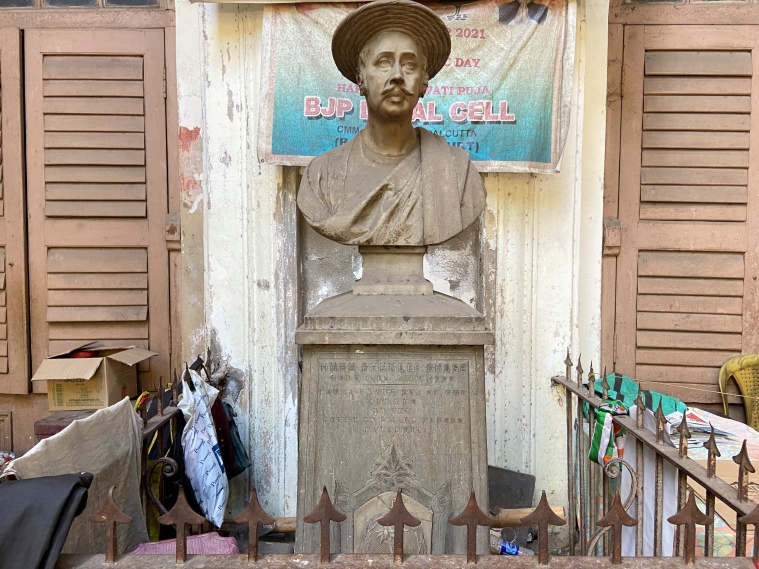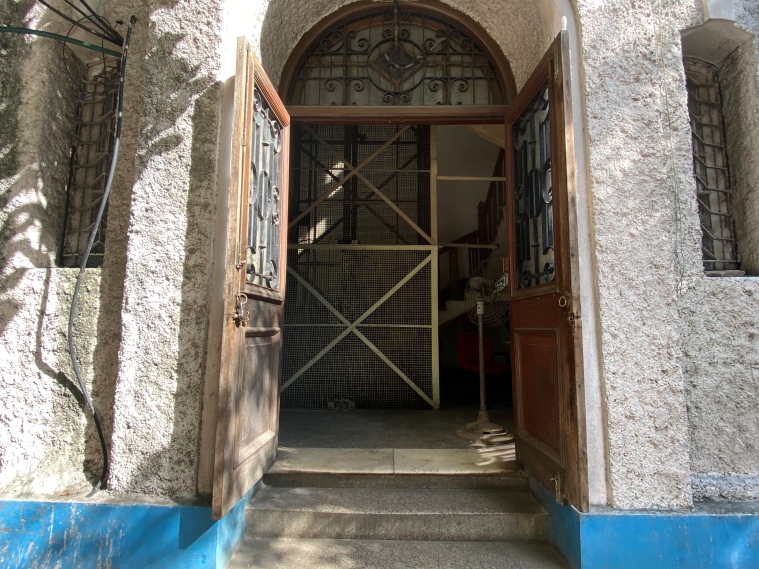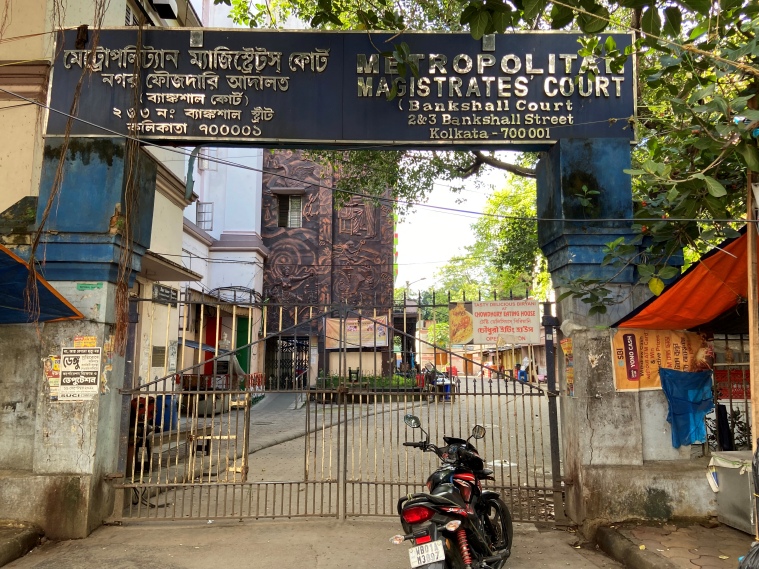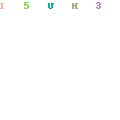In Kolkata’s central business district, Bankshall Street is most well known for housing the city’s City Sessions Court or the Metropolitan Magistrates’ Court. But the story of this street starts sometime in the 1700s when the city was still in the early years of developing into a metropolis.
In the book ‘Glimpses of India: A Grand Photographic History of the Land of Antiquity, the Vast Empire of the East’, published in 1895, an entry for Bankshall Street refers to one of the earliest courthouse buildings established on this street, preceding the City Sessions Court in its present form.
In her book ‘Calcutta: Past and Present’, published in 1905, author Kathleen Blechynden writes that Bankshall Street was named in 1792 along with several of the city’s streets, located in what now forms north and central Kolkata. (Express Photo by Neha Banka)
“The Small Cause Court, opened in 1874, is at the corner of Hare street and Bankshall street. Bankshall street runs into Hare street on the north, and also contains offices of the Revenue Board. “Bankshall” formerly meant a place for depositing ship stores, whilst the vessels were unloading cargo and being refitted,” the entry reads.
But in her book ‘Stories of the Colonial Architecture’, author Lopamudra Maitra Bajpai writes that the Bankshall Court moved to its present location in 1874, and “began within the premises of the Imperial Museum”. Maitra Bajpai is likely referring to the building that is now known as the Indian Museum, which was established in 1814, six decades before the courthouse shifted to its present address, and housed the Sadr Diwani Adalat on its premises, while simultaneously operating as a museum.
Subscriber Only Stories
There is an interesting entry in the 1841 edition of ‘The Bengal and Agra Annual Guide and Gazetteer’, pertaining to this street. The gazetteer mentions ‘Names and Situations of Streets and Principal Places’, where the origins of some of the city’s most important streets and roads during that year have been described. For Bankshall Street, the name is described as ‘Bankshall ka poorab rustah-east of Bankshall’.
 Prinsep belonged to the family of James Prinsep, in whose memory one of the most striking ghats of the city has been named. (Express Photo by Neha Banka)
Prinsep belonged to the family of James Prinsep, in whose memory one of the most striking ghats of the city has been named. (Express Photo by Neha Banka)
In her book ‘Calcutta: Past and Present’, published in 1905, author Kathleen Blechynden writes that Bankshall Street was named in 1792 along with several of the city’s streets, located in what now forms north and central Kolkata. “Bankshall Street was also named about this time from Marine House, known by the Dutch name Bankshall, which with the Master Attendant’s Office, stood on the site now occupied by the Small Cause Court. This was the same house which, some thirty-five years earlier, had been the president’s house outside the Fort. Another Dutch name then in use was Tackshall for the Custom House; this stood in the south-west angle of the Old Fort; and the street which led to it from the Great Tank was called Tackshall Street, now Koila Ghat Street. In Upjohn’s map the name is printed “Tankshall Street”, presumably a printer’s error,” writes Blechynden.
Blechynden mentions that in 1790, the British East India Company “built a dock at the Bankshall, for their pilot vessels”, but those plans were eventually put to rest. In the archives of the Museums of History, New South Wales, there is an interesting drawing of pencil and ink on paper, by William Prinsep, of Bankshall Ghat around 1830, one of the few available images of this ghat.
Advertisement
The museum’s entry for this sketch says, “Hobson-Jobson’s glossary of Anglo-Indian words and phrases offers two meanings for Bankshall, one meaning a warehouse and one meaning the office of a harbour master or other port authority.”
 Many maps of the city do not indicate the precise location of Bankshall Ghat, and historical accounts of the city indicate that it was likely filled up because the British had no use for it.
Many maps of the city do not indicate the precise location of Bankshall Ghat, and historical accounts of the city indicate that it was likely filled up because the British had no use for it.
(Express Photo by Neha Banka)
Prinsep belonged to the family of James Prinsep, in whose memory one of the most striking ghats of the city has been named. Many maps of the city do not indicate the precise location of Bankshall Ghat, and historical accounts of the city indicate that it was likely filled up because the British had no use for it.
In his book ‘A History of Calcutta’s Streets’, historian P. Thankappan Nair writes that the name Bankshall is a corruption of the Sanskrit terms ‘banik’ and ‘shalla’, which meant a marine house where traders and customers met for business. Nair is likely to have gotten this information from H.E.A Cotton’s book ‘Calcutta: Old and New’, one of the most exhaustive accounts of 19th century Calcutta.
Advertisement
“Almost opposite the entrance to Garstin’s Place is Bankshall Street. The derivation of this street, which connects Hare Street and Koila Ghat Street, has already been more than hinted at: but the word Bankshall has been a puzzle to many. John Clark Marshman traced it to a Portuguese word. The Rev. James Long took a literal view and held it to mean “a hall on the bank of a river, and so a bank hall’. According to the late Mr J.R. Rainey, it is probably a hybrid, being a compound of the English “bank” and the Sanskrit “sala”, or in the alternative traceable to the Bengalee bank, a “bend” and the Sanskrit “sala”,” Cotton writes.
Cotton goes on to explain the word’s connection with the Marine House that other historical accounts of the city have mentioned. “But it seems simpler to refer the word to the Dutch for a Marine House, which stood, as we have seen, at the corner of Bankshall Street and what is now Hare Street,” Cotton writes.
 In his book ‘A History of Calcutta’s Streets’, historian P. Thankappan Nair writes that the name Bankshall is a corruption of the Sanskrit terms ‘banik’ and ‘shalla’, which meant a marine house where traders and customers met for business. (Express Photo by Neha Banka)
In his book ‘A History of Calcutta’s Streets’, historian P. Thankappan Nair writes that the name Bankshall is a corruption of the Sanskrit terms ‘banik’ and ‘shalla’, which meant a marine house where traders and customers met for business. (Express Photo by Neha Banka)
His writings confirm that the name ‘Bankshall’ can be traced to Calcutta during the 1700s. “In any case the name first occurs as early as 1700, when the Court of Directors ordered a Bankshall or a marine yard to be built at Kedgeree, where ships of 400 tons and over could anchor, all vessels of less tonnage being directed to proceed up the river to Calcutta,” Cotton writes.
One of the most imposing buildings on this street is the office of Shaw Wallace & Company Limited, established in 1886. The company was established in 1886 by Robert Gordon Shaw and Charles William Wallace, and headquartered in Calcutta, for the operation of tea estates in its early years. A short note on The Charles Wallace Trust Post-Doctoral Fellowships established from the bequest of Wallace says, “Wallace was an Anglo-Indian entrepreneur whose businesses flourished in British India and beyond, most famously through Shaw Wallace & Company Ltd (headquartered in Calcutta), which he co-founded with Robert Gordon Shaw in 1886.”
In the 1990s, Shaw Wallace & Company Limited began diversifying, and in the three decades that followed, the company changed its business model entirely. Now, only the building bearing the company name survives, with most of its exteriors still intact. Like most occupants of the city’s old buildings today, the residents of Wallace House cannot be bothered to see the building’s independent history, its stories or even its relevance in the city’s history.
Advertisement
It is not clear whether Wallace House and the other old buildings on this street have been given heritage status by the city or the state’s heritage commission. However, the West Bengal Heritage Commission mentions that the two old court buildings within the premises of the Bankshall Court are of ‘historical importance’.
Source: https://news.google.com/__i/rss/rd/articles/CBMiamh0dHBzOi8vaW5kaWFuZXhwcmVzcy5jb20vYXJ0aWNsZS9jaXRpZXMva29sa2F0YS9iYW5rc2hhbGwtc3RyZWV0LWtvbGthdGEtYmVuZ2FsLW1hcml0aW1lLWhpc3RvcnktODM2NTEyNy_SAW9odHRwczovL2luZGlhbmV4cHJlc3MuY29tL2FydGljbGUvY2l0aWVzL2tvbGthdGEvYmFua3NoYWxsLXN0cmVldC1rb2xrYXRhLWJlbmdhbC1tYXJpdGltZS1oaXN0b3J5LTgzNjUxMjcvbGl0ZS8?oc=5


